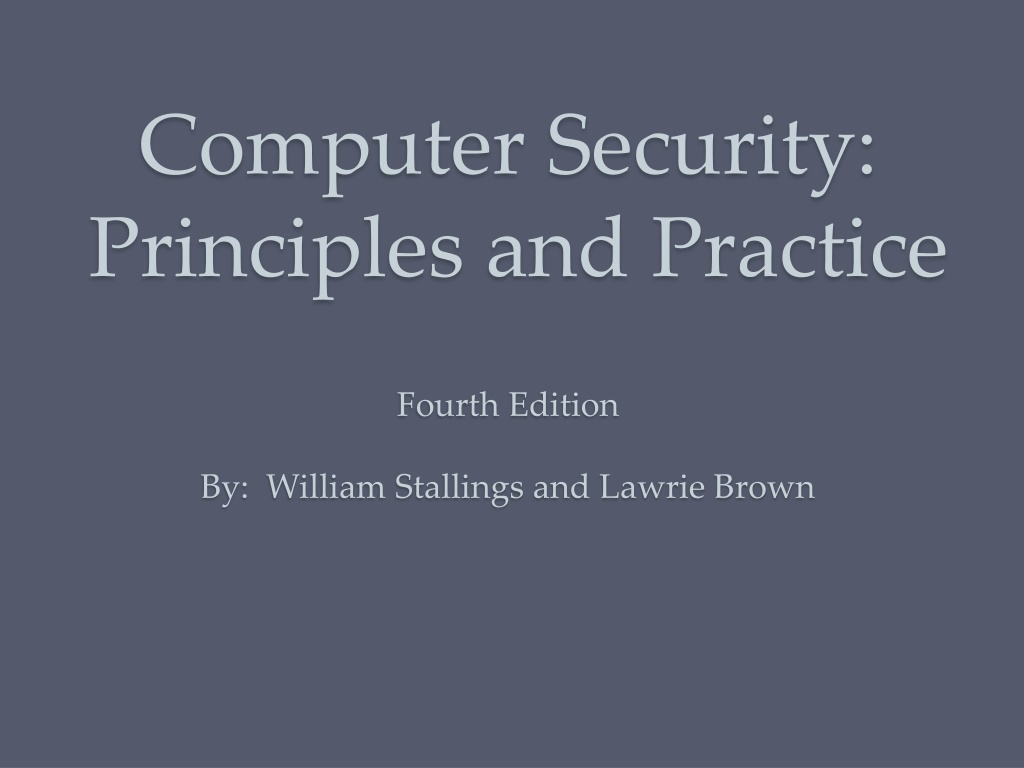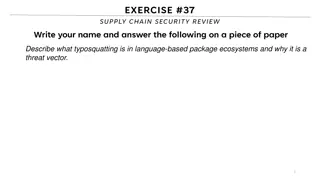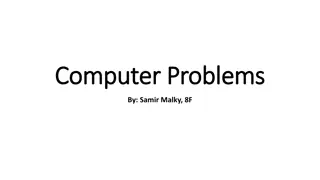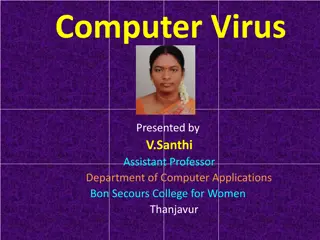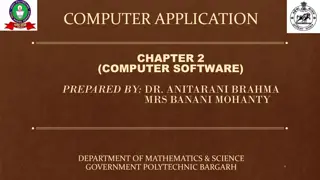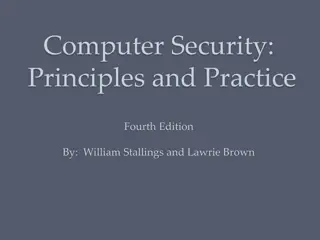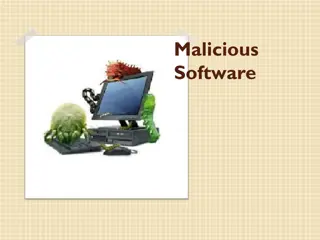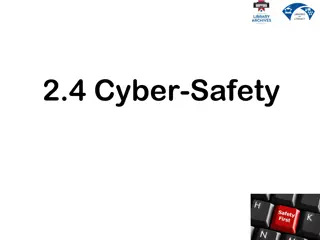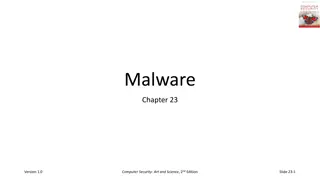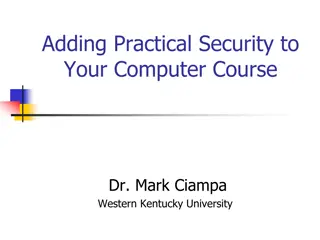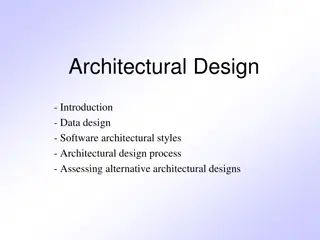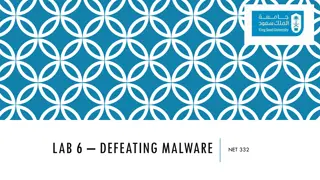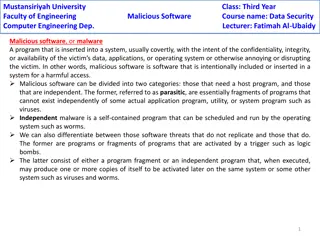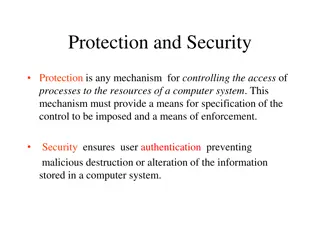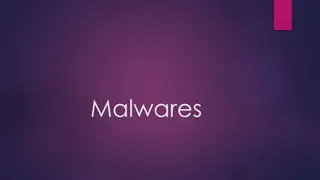Understanding Malicious Software in Computer Security
In "Computer Security: Principles and Practice," the chapter on Malicious Software covers various types of malware such as viruses, adware, worms, and rootkits. It defines malware, Trojan horses, and other related terms like backdoors, keyloggers, and spyware. The chapter also discusses advanced threats like advanced persistent threats, attack kits, and zombie programs. Understanding these forms of malware is crucial for protecting systems and data from cyber threats.
Download Presentation

Please find below an Image/Link to download the presentation.
The content on the website is provided AS IS for your information and personal use only. It may not be sold, licensed, or shared on other websites without obtaining consent from the author. Download presentation by click this link. If you encounter any issues during the download, it is possible that the publisher has removed the file from their server.
E N D
Presentation Transcript
Computer Security: Principles and Practice Fourth Edition By: William Stallings and Lawrie Brown
Chapter 6 Malicious Software
Malware NIST 800-83 defines malware as: a program that is inserted into a system, usually covertly, with the intent of compromising the confidentiality, integrity, or availability of the victim s data, applications, or operating system or otherwise annoying or disrupting the victim.
Trojan horse A computer program that appears to have a useful function, but also has a hidden and potentially malicious function that evades security mechanisms, sometimes by exploiting legitimate authorizations of a system entity that invokes the Trojan horse program. Name Description Advanced persistent threat Cybercrime directed at business and political targets, using a wide variety of intrusion technologies and malware, applied persistently and effectively to specific targets over an extended period, often attributed to state-sponsored organizations. Virus Malware that, when executed, tries to replicate itself into other executable machine or script code; when it succeeds the code is said to be infected. When the infected code is executed, the virus also executes. Adware Advertising that is integrated into software. It can result in pop-up ads or redirection of a browser to a commercial site. Worm A computer program that can run independently and can propagate a complete working version of itself onto other hosts on a network, usually by exploiting software vulnerabilities in the target system. Attack Kit Set of tools for generating new malware automatically using a variety of supplied propagation and payload mechanisms. Zombie, bot Program activated on an infected machine that is activated to launch attacks on other machines. Auto-rooter Malicious hacker tools used to break into new machines remotely. Backdoor (trapdoor) Any mechanisms that bypasses a normal security check; it may allow unauthorized access to functionality in a program, or onto a compromised system. Table 6.1 Downloaders Code that installs other items on a machine that is under attack. It is normally included in the malware code first inserted on to a compromised system to then import a larger malware package. Drive-by download An attack using code in a compromised web site that exploits a browser vulnerability to attack a client system when the site is viewed. Malware Terminology Exploits Code specific to a single vulnerability or set of vulnerabilities. Flooders (DoS client) Used to generate a large volume of data to attack networked computer systems, by carrying out some form of denial-of-service (DoS) attack. Keyloggers Captures keystrokes on a compromised system. Logic bomb Code inserted into malware by an intruder. A logic bomb lies dormant until a predefined condition is met; the code then triggers an unauthorized act. (Table can be found on page 185 in the textbook.) Macro Virus A type of virus that uses macro or scripting code, typically embedded in a document, and triggered when the document is viewed or edited, to run and replicate itself into other such documents. Mobile Code Software (e.g., script, macro, or other portable instruction) that can be shipped unchanged to a heterogeneous collection of platforms and execute with identical semantics. Rootkit Set of hacker tools used after attacker has broken into a computer system and gained root-level access. Spammer Programs Used to send large volumes of unwanted e-mail. Spyware Software that collects information from a computer and transmits it to another system by monitoring keystrokes, screen data and/or network traffic; or by scanning files on the system for sensitive information.
Classification of Malware Classified into two broad categories: Also classified by: Based first on how it spreads or propagates to reach the desired targets Those that need a host program (parasitic code such as viruses) Then on the actions or payloads it performs once a target is reached Those that are independent, self-contained programs (worms, trojans, and bots) Malware that does not replicate (trojans and spam e-mail) Malware that does replicate (viruses and worms)
Types of Malicious Software (Malware) Propagation mechanisms include: Infection of existing content by viruses that is subsequently spread to other systems Exploit of software vulnerabilities by worms or drive- by-downloads to allow the malware to replicate Social engineering attacks that convince users to bypass security mechanisms to install Trojans or to respond to phishing attacks Payload actions performed by malware once it reaches a target system can include: Corruption of system or data files Theft of service/make the system a zombie agent of attack as part of a botnet Theft of information from the system/keylogging Stealthing/hiding its presence on the system
Attack Kits Initially the development and deployment of malware required considerable technical skill by software authors The development of virus-creation toolkits in the early 1990s and then more general attack kits in the 2000s greatly assisted in the development and deployment of malware Toolkits are often known as crimeware Include a variety of propagation mechanisms and payload modules that even novices can deploy Variants that can be generated by attackers using these toolkits creates a significant problem for those defending systems against them Examples are: Zeus Angler
Attack Sources Another significant malware development is the change from attackers being individuals often motivated to demonstrate their technical competence to their peers to more organized and dangerous attack sources such as: Organizations that sell their services to companies and nations Politically motivated attackers National government agencies Organized crime Criminals This has significantly changed the resources available and motivation behind the rise of malware and has led to development of a large underground economy involving the sale of attack kits, access to compromised hosts, and to stolen information
Advanced Persistent Threats (APTs) Well-resourced, persistent application of a wide variety of intrusion technologies and malware to selected targets (usually business or political) Typically attributed to state-sponsored organizations and criminal enterprises Differ from other types of attack by their careful target selection and stealthy intrusion efforts over extended periods High profile attacks include Aurora, RSA, APT1, and Stuxnet
APT Characteristics Advanced Used by the attackers of a wide variety of intrusion technologies and malware including the development of custom malware if required The individual components may not necessarily be technically advanced but are carefully selected to suit the chosen target Persistent Determined application of the attacks over an extended period against the chosen target in order to maximize the chance of success A variety of attacks may be progressively applied until the target is compromised Threats Threats to the selected targets as a result of the organized, capable, and well-funded attackers intent to compromise the specifically chosen targets The active involvement of people in the process greatly raises the threat level from that due to automated attacks tools, and also the likelihood of successful attacks
APT Attacks Aim: Varies from theft of intellectual property or security and infrastructure related data to the physical disruption of infrastructure Techniques used: Social engineering Spear-phishing email Drive-by-downloads from selected compromised websites likely to be visited by personnel in the target organization Intent: To infect the target with sophisticated malware with multiple propagation mechanisms and payloads Once they have gained initial access to systems in the target organization a further range of attack tools are used to maintain and extend their access
Viruses Piece of software that infects programs Modifies them to include a copy of the virus Replicates and goes on to infect other content Easily spread through network environments When attached to an executable program a virus can do anything that the program is permitted to do Executes secretly when the host program is run Specific to operating system and hardware Takes advantage of their details and weaknesses
Virus Components Infection mechanism Means by which a virus spreads or propagates Also referred to as the infection vector Trigger Event or condition that determines when the payload is activated or delivered Sometimes known as a logic bomb Payload What the virus does (besides spreading) May involve damage or benign but noticeable activity
Virus Phases Dormant phase Will eventually be activated by some event Not all viruses have this stage Virus is idle Triggering phase Virus is activated to perform the function for which it was intended Can be caused by a variety of system events Propagation phase Each infected program will now contain a clone of the virus which will itself enter a propagation phase Virus places a copy of itself into other programs or into certain system areas on the disk May not be identical to the propagating version Execution phase Function is performed May be harmless or damaging
Macro and Scripting Viruses NISTIR 7298 defines a macro virus as: a virus that attaches itself to documents and uses the macro programming capabilities of the document s application to execute and propagate Macro viruses infect scripting code used to support active content in a variety of user document types Are threatening for a number of reasons: Is platform independent Infect documents, not executable portions of code Are easily spread Because they infect user documents rather than system programs, traditional file system access controls are of limited use in preventing their spread, since users are expected to modify them Are much easier to write or to modify than traditional executable viruses
macro Document_Open disable Macro menu and some macro security features if called from a user document copy macro code into Normal template file else copy macro code into user document being opened end if if registry key Melissa not present if Outlook is email client for first 50 addresses in address book send email to that address with currently infected document attached end for end if create registry key Melissa end if if minute in hour equals day of month insert text into document being opened end if end macro Figure 6.1 Melissa Macro Virus Pseudocode
Virus Classifications Classification by concealment strategy Classification by target Boot sector infector Infects a master boot record or boot record and spreads when a system is booted from the disk containing the virus File infector Infects files that the operating system or shell considers to be executable Macro virus Infects files with macro or scripting code that is interpreted by an application Multipartite virus Infects files in multiple ways Encrypted virus A portion of the virus creates a random encryption key and encrypts the remainder of the virus Stealth virus A form of virus explicitly designed to hide itself from detection by anti- virus software Polymorphic virus A virus that mutates with every infection Metamorphic virus A virus that mutates and rewrites itself completely at each iteration and may change behavior as well as appearance
Worms Program that actively seeks out more machines to infect and each infected machine serves as an automated launching pad for attacks on other machines Exploits software vulnerabilities in client or server programs Can use network connections to spread from system to system Spreads through shared media (USB drives, CD, DVD data disks) E-mail worms spread in macro or script code included in attachments and instant messenger file transfers Upon activation the worm may replicate and propagate again Usually carries some form of payload First known implementation was done in Xerox Palo Alto Labs in the early 1980s
Worm Replication Electronic mail or instant messenger facility Worm e-mails a copy of itself to other systems Sends itself as an attachment via an instant message service Creates a copy of itself or infects a file as a virus on removable media File sharing Remote execution capability Worm executes a copy of itself on another system Remote file access or transfer capability Worm uses a remote file access or transfer service to copy itself from one system to the other Remote login capability Worm logs onto a remote system as a user and then uses commands to copy itself from one system to the other
Target Discovery Scanning (or fingerprinting) First function in the propagation phase for a network worm Searches for other systems to infect Random Each compromised host probes random addresses in the IP address space using a different seed This produces a high volume of Internet traffic which may cause generalized disruption even before the actual attack is launched Hit-list The attacker first compiles a long list of potential vulnerable machines Once the list is compiled the attacker begins infecting machines on the list Each infected machine is provided with a portion of the list to scan This results in a very short scanning period which may make it difficult to detect that infection is taking place Topological This method uses information contained on an infected victim machine to find more hosts to scan Local subnet If a host can be infected behind a firewall that host then looks for targets in its own local network The host uses the subnet address structure to find other hosts that would otherwise be protected by the firewall
Slow start phase Fast spread sphase Slow finish phase 1.0 Fraction of hosts infected 0.8 0.6 0.4 Fraction of hosts not infected 0.2 0 Time Figure 6.2 Worm Propagation Model
Morris Worm Earliest significant worm infection Released by Robert Morris in 1988 Designed to spread on UNIX systems Attempted to crack local password file to use login/password to logon to other systems Exploited a bug in the finger protocol which reports the whereabouts of a remote user Exploited a trapdoor in the debug option of the remote process that receives and sends mail Successful attacks achieved communication with the operating system command interpreter Sent interpreter a bootstrap program to copy worm over
Recent Worm Attacks Melissa 1998 E-mail worm First to include virus, worm and Trojan in one package Code Red July 2001 Exploited Microsoft IIS bug Probes random IP addresses Consumes significant Internet capacity when active Code Red II August 2001 Also targeted Microsoft IIS Installs a backdoor for access Nimda September 2001 Had worm, virus and mobile code characteristics Spread using e-mail, Windows shares, Web servers, Web clients, backdoors SQL Slammer Early 2003 Exploited a buffer overflow vulnerability in SQL server compact and spread rapidly Sobig.F Late 2003 Exploited open proxy servers to turn infected machines into spam engines Mydoom 2004 Mass-mailing e-mail worm Installed a backdoor in infected machines Warezov 2006 Creates executables in system directories Sends itself as an e-mail attachment Can disable security related products Conficker (Downadup) November 2008 Exploits a Windows buffer overflow vulnerability Most widespread infection since SQL Slammer Stuxnet 2010 Restricted rate of spread to reduce chance of detection Targeted industrial control systems
WannaCry Ransomware attack in May 2017 that spread extremely fast over a period of hours to days, infecting hundreds of thousands of systems belonging to both public and private organizations in more than 150 countries It spread as a worm by aggressively scanning both local and random remote networks, attempting to exploit a vulnerability in the SMB file sharing service on unpatched Windows systems This rapid spread was only slowed by the accidental activation of a kill-switch domain by a UK security researcher Once installed on infected systems, it also encrypted files, demanding a ransom payment to recover them
Multiplatform Metamorphic Multi-exploit Worm Technology Ultrafast spreading Polymorphic
Mobile Code NIST SP 800-28 defines mobile code as programs that can be shipped unchanged to a heterogeneous collection of platforms and executed with identical semantics Transmitted from a remote system to a local system and then executed on the local system Often acts as a mechanism for a virus, worm, or Trojan horse Takes advantage of vulnerabilities to perform its own exploits Popular vehicles include: Java applets ActiveX JavaScript VBScript Most common ways of using mobile code for malicious operations on local system are: Cross-site scripting Interactive and dynamic Web sites E-mail attachments Downloads from untrusted sites or of untrusted software
Mobile Phone Worms First discovery was Cabir worm in 2004 Then Lasco and CommWarrior in 2005 Communicate through Bluetooth wireless connections or MMS Target is the smartphone Can completely disable the phone, delete data on the phone, or force the device to send costly messages CommWarrior replicates by means of Bluetooth to other phones, sends itself as an MMS file to contacts and as an auto reply to incoming text messages
Drive-By-Downloads Exploits browser and plugin vulnerabilities so when the user views a webpage controlled by the attacker, it contains code that exploits the bug to download and install malware on the system without the user s knowledge or consent In most cases the malware does not actively propagate as a worm does Spreads when users visit the malicious Web page
Watering-Hole Attacks A variant of drive-by-download used in highly targeted attacks The attacker researches their intended victims to identify websites they are likely to visit, then scans these sites to identify those with vulnerabilities that allow their compromise They then wait for one of their intended victims to visit one of the compromised sites Attack code may even be written so that it will only infect systems belonging to the target organization and take no action for other visitors to the site This greatly increases the likelihood of the site compromise remaining undetected
Malvertising Places malware on websites without actually compromising them The attacker pays for advertisements that are highly likely to be placed on their intended target websites and incorporate malware in them Using these malicious ads, attackers can infect visitors to sites displaying them The malware code may be dynamically generated to either reduce the chance of detection or to only infect specific systems Has grown rapidly in recent years because they are easy to place on desired websites with few questions asked and are hard to track Attackers can place these ads for as little as a few hours, when they expect their intended victims could be browsing the targeted websites, greatly reducing their visibility
Clickjacking Vulnerability used by an attacker to collect an infected user s clicks The attacker can force the user to do a variety of things from adjusting the user s computer settings to unwittingly sending the user to Web sites that might have malicious code By taking advantage of Adobe Flash or JavaScript an attacker could even place a button under or over a legitimate button making it difficult for users to detect A typical attack uses multiple transparent or opaque layers to trick a user into clicking on a button or link on another page when they were intending to click on the top level page The attacker is hijacking clicks meant for one page and routing them to another page Also known as a user- interface (UI) redress attack Using a similar technique, keystrokes can also be hijacked A user can be led to believe they are typing in the password to their email or bank account, but are instead typing into an invisible frame controlled by the attacker
Social Engineering Tricking users to assist in the compromise of their own systems Mobile phone Trojans Spam Trojan horse Unsolicited bulk Program or utility containing harmful hidden code First appeared in 2004 (Skuller) e-mail Significant carrier of malware Used to accomplish functions that the attacker could not accomplish directly Target is the smartphone Used for phishing attacks
Payload System Corruption Klez Chernobyl virus Mass mailing worm infecting Windows 95 to XP systems First seen in October 2001 Spreads by e-mailing copies of itself to addresses found in the address book and in files on the system It can stop and delete some anti-virus programs running on the system On trigger date causes files on the hard drive to become empty First seen in 1998 Example of a destructive parasitic memory-resident Windows 95 and 98 virus Infects executable files when they are opened and when a trigger date is reached, the virus deletes data on the infected system by overwriting the first megabyte of the hard drive with zeroes, resulting in massive corruption of the entire file system Ransomware Encrypts the user s data and demands payment in order to access the key needed to recover the information PC Cyborg Trojan (1989) Mid-2006 a number of worms and Trojans appeared that used public-key cryptography with incresasingly larger key sizes to encrypt data The user needed to pay a ransom, or to make a purchase from certain sites, in order to receive the key to decrypt this data
Ransomware WannaCry Infected a large number of systems in many countries in May 2017 When installed on infected systems, it encrypted a large number of files and then demanded a ransom payment in Bitcoins to recover them Recovery of this information was generally only possible if the organization had good backups and an appropriate incident response and disaster recovery plan Targets widened beyond personal computer systems to include mobile devices and Linux servers Tactics such as threatening to publish sensitive personal information, or to permanently destroy the encryption key after a short period of time, are sometimes used to increase the pressure on the victim to pay up
Payload System Corruption Real-world damage Causes damage to physical equipment Chernobyl virus rewrites BIOS code Stuxnet worm Targets specific industrial control system software There are concerns about using sophisticated targeted malware for industrial sabotage Logic bomb Code embedded in the malware that is set to explode when certain conditions are met
Payload Attack Agents Bots Takes over another Internet attached computer and uses that computer to launch or manage attacks Botnet - collection of bots capable of acting in a coordinated manner Uses: Distributed denial-of-service (DDoS) attacks Spamming Sniffing traffic Keylogging Spreading new malware Installing advertisement add-ons and browser helper objects (BHOs) Attacking IRC chat networks Manipulating online polls/games
Remote Control Facility Distinguishes a bot from a worm Worm propagates itself and activates itself Bot is initially controlled from some central facility Typical means of implementing the remote control facility is on an IRC server Bots join a specific channel on this server and treat incoming messages as commands More recent botnets use covert communication channels via protocols such as HTTP Distributed control mechanisms use peer-to-peer protocols to avoid a single point of failure
Payload Information Theft Keyloggers and Spyware Keylogger Captures keystrokes to allow attacker to monitor sensitive information Typically uses some form of filtering mechanism that only returns information close to keywords ( login , password ) Spyware Subverts the compromised machine to allow monitoring of a wide range of activity on the system Monitoring history and content of browsing activity Redirecting certain Web page requests to fake sites Dynamically modifying data exchanged between the browser and certain Web sites of interest
Payload Information Theft Phishing Exploits social engineering to leverage the user s trust by masquerading as communication from a trusted source Include a URL in a spam e-mail that links to a fake Web site that mimics the login page of a banking, gaming, or similar site Suggests that urgent action is required by the user to authenticate their account Attacker exploits the account using the captured credentials Spear-phishing Recipients are carefully researched by the attacker E-mail is crafted to specifically suit its recipient, often quoting a range of information to convince them of its authenticity
Payload Stealthing Backdoor Also known as a trapdoor Secret entry point into a program allowing the attacker to gain access and bypass the security access procedures Maintenance hook is a backdoor used by Programmers to debug and test programs Difficult to implement operating system controls for backdoors in applications
Payload - Stealthing Rootkit Set of hidden programs installed on a system to maintain covert access to that system Hides by subverting the mechanisms that monitor and report on the processes, files, and registries on a computer Gives administrator (or root) privileges to attacker Can add or change programs and files, monitor processes, send and receive network traffic, and get backdoor access on demand
Rootkit Classification Characteristics Memory based Persistent User mode Virtual machine based Kernel mode External mode
knark_fork( ) knark_read( ) fork entry read entry fork entry read entry knark_execve( ) execve entry chdir entry execve entry chdir entry sys_fork( ) sys_fork( ) sys_read( ) sys_read( ) system call table system call table sys_execve( ) sys_execve( ) sys_chdir( ) sys_chdir( ) (a) Normal kernel memory layout (b) After nkark install Figure 6.3 System Call Table Modification by Rootkit
Malware Countermeasure Approaches Ideal solution to the threat of malware is prevention Four main elements of prevention: Policy Awareness Vulnerability mitigation Threat mitigation If prevention fails, technical mechanisms can be used to support the following threat mitigation options: Detection Identification Removal
Generations of Anti-Virus Software First generation: simple scanners Requires a malware signature to identify the malware Limited to the detection of known malware Second generation: heuristic scanners Uses heuristic rules to search for probable malware instances Another approach is integrity checking Third generation: activity traps Memory-resident programs that identify malware by its actions rather than its structure in an infected program Fourth generation: full-featured protection Packages consisting of a variety of anti-virus techniques used in conjunction Include scanning and activity trap components and access control capability
Sandbox Analysis Running potentially malicious code in an emulated sandbox or on a virtual machine Allows the code to execute in a controlled environment where its behavior can be closely monitored without threatening the security of a real system Running potentially malicious software in such environments enables the detection of complex encrypted, polymorphic, or metamorphic malware The most difficult design issue with sandbox analysis is to determine how long to run each interpretation
Host-Based Behavior-Blocking Software Integrates with the operating system of a host computer and monitors program behavior in real time for malicious action Blocks potentially malicious actions before they have a chance to affect the system Blocks software in real time so it has an advantage over anti-virus detection techniques such as fingerprinting or heuristics Limitations Because malicious code must run on the target machine before all its behaviors can be identified, it can cause harm before it has been detected and blocked
Perimeter Scanning Approaches Anti-virus software typically included in e-mail and Web proxy services running on an organization s firewall and IDS May also be included in the traffic analysis component of an IDS May include intrusion prevention measures, blocking the flow of any suspicious traffic Approach is limited to scanning malware Ingress monitors Egress monitors Located at the egress point of individual LANs as well as at the border between the enterprise network and the Internet Located at the border between the enterprise network and the Internet One technique is to look for incoming traffic to unused local IP addresses Monitors outgoing traffic for signs of scanning or other suspicious behavior Two types of monitoring software
Summary Types of malicious software (malware) Broad classification of malware Attack kits Attack sources Advanced persistent threat Propagation-vulnerability exploit-worms Target discovery Worm propagation model The Morris Worm Brief history of worm attacks State of worm technology Mobile code Mobile phone worms Client-side vulnerabilities Drive-by-downloads Clickjacking Payload-stealthing-backdoors, rootkits Backdoor Rootkit Kernel mode rootkits Virtual machine and other external rootkits Propagation-social engineering- span E-mail, Trojans Spam E-mail Trojan horses Mobile phone Trojans Payload-system corruption Data destruction Real-world damage Logic bomb Payload-attack agent-zombie, bots Uses of bots Remote control facility Payload-information theft- keyloggers, phishing, spyware Credential theft, keyloggers, and spyware Phishing and identity theft Reconnaissance, espionage, and data exfiltration Countermeasures Malware countermeasure approaches Host-based scanners Signature-based anti-virus Perimeter scanning approaches Distributed intelligence gathering approaches
